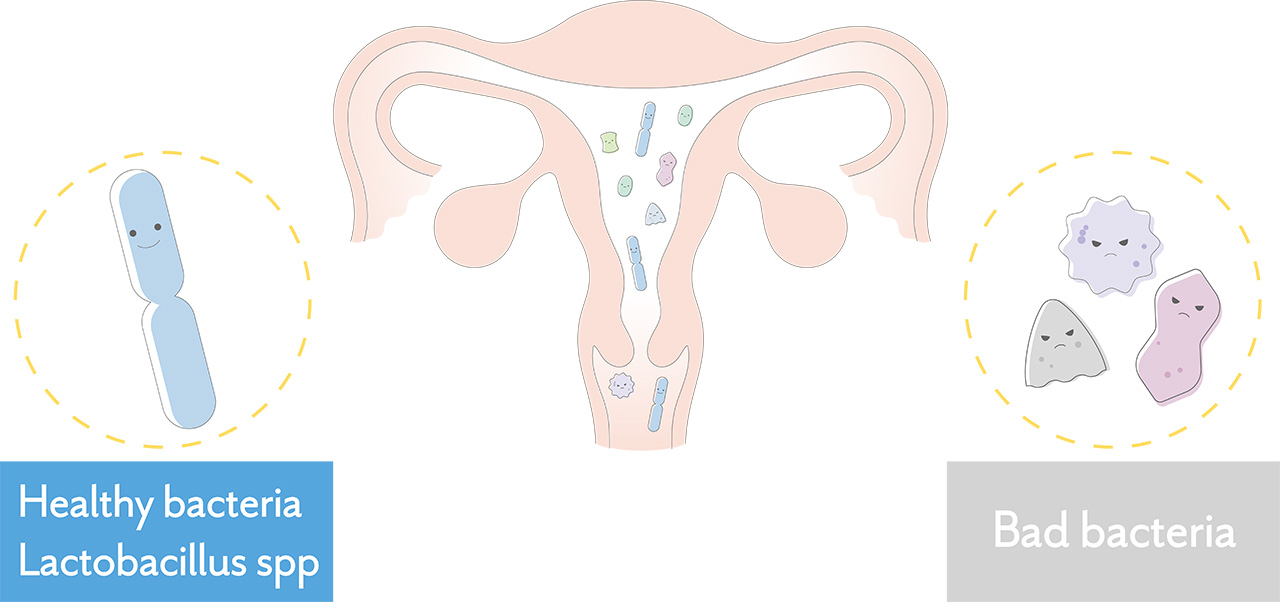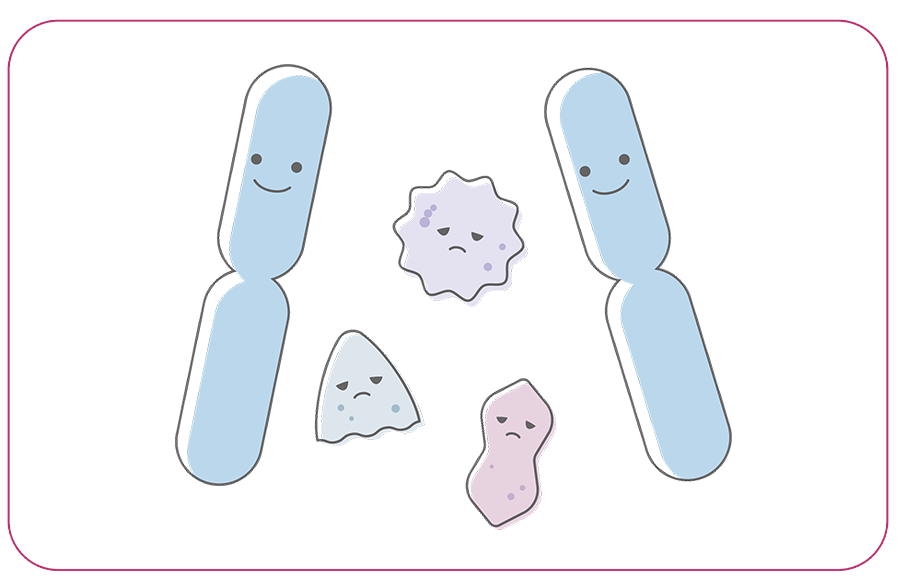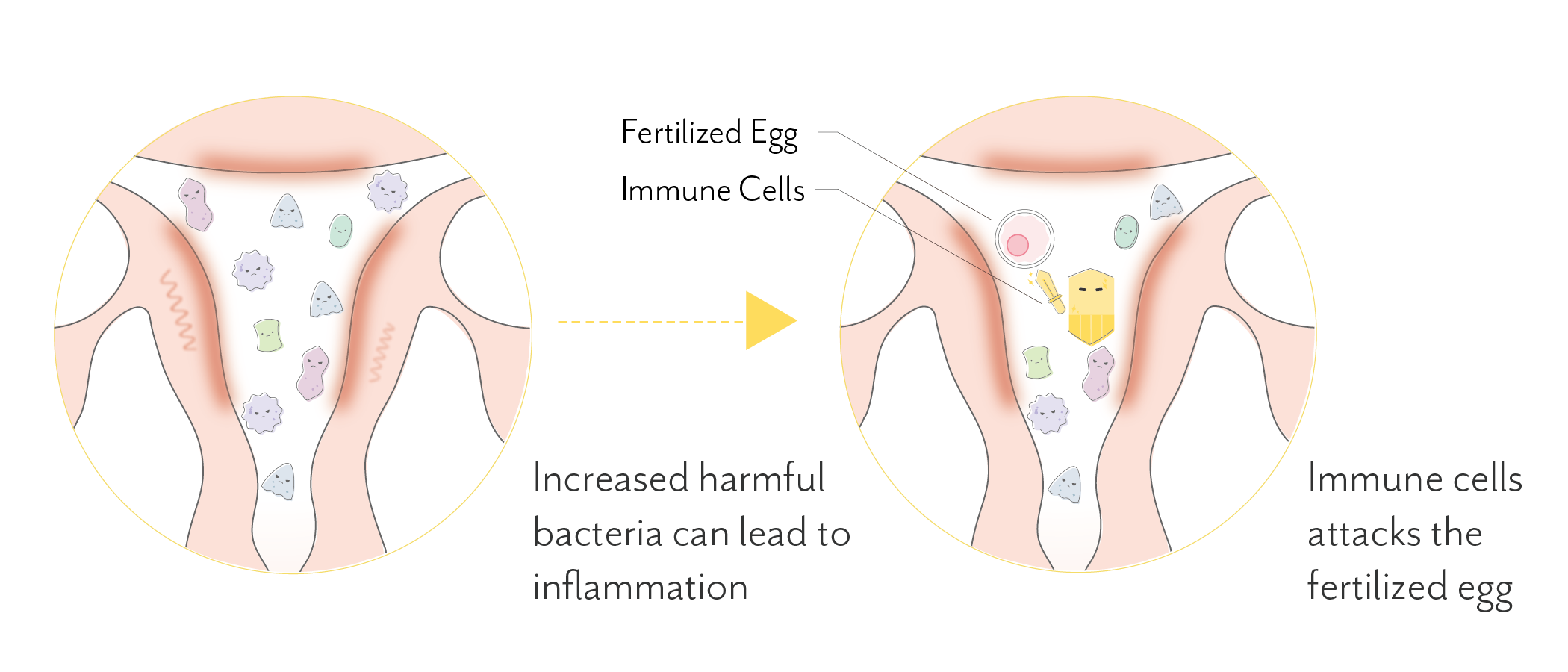Endometrial Microbiome Test
Learn About the Endometrial Microbiome Test in 3 Minutes
What Is the Endometrial Microbiome?
You may have heard of the term "gut microbiome" or “gut flora” before. Our intestines contain many types of bacteria that help maintain a healthy environment. Under a microscope, these bacteria look like a colorful field of flowers—hence the name "flora." Until recently, the uterus was thought to be sterile. But researchers have discovered that the uterus contains bacteria as well.[1] Just like the gut, the uterus also hosts a variety of bacteria, and this community is called the “endometrial microbiome.”

The Endometrial Microbiome Can Impact Pregnancy and Birth
There are many types of bacteria, and when the balance is disrupted—especially if the good bacteria decrease—it may affect your ability to get pregnant or carry a pregnancy to term. Research shows that an imbalanced endometrial microbiome can be linked to infertility, miscarriage, or preterm birth.
One study compared pregnancy and live birth rates between women with high and low levels of Lactobacillus—a type of beneficial bacteria in the uterus.
In women whose Lactobacillus made up 90% or more of their endometrial microbiome (considered balanced), the pregnancy rate was 70.6%, and the live birth rate was 58.8%.
In women with less than 90% Lactobacillus (considered imbalanced), the pregnancy rate dropped to 33.3%, and the live birth rate was only 6.7%—about one-tenth that of the balanced group.[2]

What Makes for a Healthy Endometrial Microbiome?
A healthy uterine environment is one with a high proportion of Lactobacillus—a beneficial type of lactic acid bacteria.
How Lactobacillus Helps Create a Healthier Uterine Environment
Improves the Uterine Environment
Lactobacillus breaks down sugars and produces lactic acid, keeping the reproductive tract slightly acidic. This helps prevent harmful bacteria from growing.

Reduces Immune Attacks on Fertilized Eggs
When harmful bacteria increase, they may cause inflammation, making immune cells more active. These immune cells may mistakenly attack the fertilized egg. Lactobacillus helps reduce the number of harmful bacteria and inflammation, which may calm the immune response.

Low levels of Lactobacillus may also contribute to conditions like bacterial vaginosis or endometritis. That’s why it’s important to support a healthy balance of good bacteria. [3][4][5]
How Do You Know If You Have Enough Good Bacteria (Lactobacillus)?
You can find out through an Endometrial Microbiome Test.
What Is the Endometrial Microbiome Test?
The Endometrial Microbiome Test checks the balance of good bacteria—specifically Lactobacillus—in the vagina or uterus.
Varinos Inc. was the first in the world to make this test available for clinical use.
- At a clinic, a doctor will gently collect a sample from your vagina or uterine cavity using a swab or pipette. The sample is then analyzed at a specialized lab to look at the bacterial DNA. This allows us to accurately measure the proportion of Lactobacillus present.
- Thanks to years of research and a highly skilled team, Varinos is able to provide clinics with highly precise results.
- The test analyzes bacterial DNA, which also makes it possible to detect other bacteria—such as naturally occurring microbes or those linked to conditions like bacterial vaginosis. For this reason, many fertility clinics use this test to help guide treatment plans.

When Should You Consider Getting the Test?
Please talk to your doctor about the best time to take this test.
Right now, the test is often used for people who:
・Have experienced repeated implantation failure or recurrent miscarriage
・Have gone through many tests but still don’t know why they can’t get pregnant
More recently, clinics are also starting to recommend this test earlier in fertility treatment because of how important the uterine microbiome is. Since the uterus plays a key role in pregnancy, this test may also be helpful for:
・Anyone who is planning to get pregnant
・Anyone who wants to better understand their current uterine environment
Who is the test for?
This test may be suitable for individuals who are:
People who are concerned about their endometrial microbiome often take this test at fertility clinics.
If you're curious about your own uterine environment, talk to your doctor.
What If the Test Shows an Imbalance?
Your test report will show the percentage of good bacteria (Lactobacillus).
If other types of bacteria are found, the report will also list which ones they are and in what amounts.
Based on these results, your doctor can create a treatment plan to help increase the Lactobacillus or address any harmful bacteria.
This may involve antibiotics, supplements, or lifestyle changes.
Treatment is personalized based on your unique bacterial balance. Please consult your doctor for more details.
-
Case1:Low Lactobacillus
If you have some Lactobacillus but not enough, your doctor may suggest improving your diet and lifestyle, along with taking supplements that support a healthy microbiome. This can help create an environment where Lactobacillus can grow.

-
Case2:Harmful Bacteria Are Present
If specific harmful bacteria are found, your doctor may prescribe antibiotics to reduce them. At the same time, improving diet and taking the right nutrients can help Lactobacillus thrive.

-
Case3:No Lactobacillus Detected
If no Lactobacillus is found, your doctor may recommend taking it directly as a supplement. Along with diet and lifestyle changes, this helps build an environment where Lactobacillus can take hold and grow.

Interested in the Endometrial Microbiome Test?
The Endometrial Microbiome Test is available through medical clinics.
Ask your doctor if it’s right for you.
If you live in Japan, please refer to the following.
Endometrial Microbiome Test List of facilities
*Click on a prefecture on the map to display a list of clinics in that prefecture.
*Please note that some facilities not listed may offer the service.
If you wish to visit a medical institution not listed, please contact the institution directly to confirm availability.
If you don't know where your nearest clinic is, please send an email to info@varinos.com. Example: Near Shinjuku-ku, Tokyo

Hokkaido
札幌市厚別区青葉町6丁目1番9号
011‐893‐3207
北海道函館市石川町41-9
0138-46-6660
北海道釧路市中園町8番1号
0154-25-7788
北海道札幌市北区麻生町2丁目2-7 中川ビル2階
011-792-8850
北海道帯広市東3条南9丁目3番地
0155-67-1162
北海道札幌市中央区北1条西4丁目1-1
011-200-1122
北海道札幌市北区北7条西4丁目1-2KDX札幌ビル4F
011-700-5880
札幌市北区北23条西3丁目2番37号第2北進建鉄ビル2F
011-792-6691
北海道札幌市中央区北3条東8丁目5番地
011-261-5331
北海道札幌市手稲区前田1条12丁目1-40
011-681-8111
北海道札幌市中央区北1条東1丁目
011-251-2221
北海道苫小牧市弥生町2丁目12−5
0144-73-5353
北海道札幌市豊平区平岸3条13丁目5-21 南平岸ビル1~3階
011-833-7773
北海道札幌市中央区北2条西28丁目1-26 エストラーダ円山2F
011-215-8212
Tohoku region
Aomori Prefecture
青森県青森市浜田3-3-7
017-729-4103
Iwate Prefecture
岩手県盛岡市盛岡駅前通15-5-3F
019-613-4124
岩手県盛岡市若園町10番4号
019-622-9433
Miyagi Prefecture
宮城県仙台市青葉区本町1-1-1 大樹生命仙台本町ビル3F
022-722-8841
宮城県岩沼市里の杜3丁目5-5
0223-23-3111
宮城県仙台市太白区大野田4-31-3
022-248-5001
Akita Prefecture
該当のクリニックがありません。
Yamagata Prefecture
山形県山形市大手町9-25
023-641-6467
山形県天童市南小畑4丁目1-1
023-652-1117
山形県米沢市東三丁目9-3
0238-26-1537
Fukushima Prefecture
福島県福島市栄町6-1 エスタビル12F
024-523-1132
Kanto region
ibaraki Prefecture
茨城県水戸市三の丸3-11-1
029-231-1124
茨城県つくば市竹園一丁目6番地1つくば三井ビル4階
029-863-6111
茨城県つくば市天久保2-1-1
029-853-3900
茨城県日立市鹿島町2丁目17-4
0294-27-7521
Gunma Prefecture
群馬県前橋市昭和町三丁目39番15号
027-220-7111
群馬県高崎市東町80‐7
027-326-7711
群馬県高崎市あら町136-1
027-310-7701
群馬県前橋市石倉町5-22-1
027-253-4152
群馬県太田市台之郷町257
0276-45-8818
群馬県前橋市下小出町1-5-22
027-234-4135
Saitama Prefecture
埼玉県さいたま市大宮区大成町3-542
048-663-0005
埼玉県さいたま市大宮区桜木町1-7-5 ソニックシティビル14F
048-648-1657
埼玉県所沢市金山町8-6
04-2922-0221
埼玉県越谷市南越谷2-1-50
048-965-2028
埼玉県羽生市中岩瀬612
048-562-3505
埼玉県さいたま市岩槻区本町2-10-5
048-757-3511
埼玉県比企郡小川町大塚285
0493-72-2233
埼玉県志木市本町5-25-8 ドゥーセットビル3階
048-423-6428
Chiba Prefecture
千葉県流山市おおたかの森西1ー3ー5K.M おおたかの森2F
04ー7170ー1541
千葉県柏市若柴226番地41中央144街区1アベニフ柏の葉102号
04-7137-2525
千葉県鎌ヶ谷市新鎌ヶ谷4-2-10
047-442-3377
千葉県鴨川市東町929番地
04-7092-2211
千葉県浦安市北栄1-11-20-3F
047-700-7077
千葉県木更津市万石358
0438-41-3700
千葉県千葉市中央区新町18−14 千葉新町ビル6階
043-243-8024
千葉県千葉市中央区富士見1ー14ー11常盤ビル4F
043ー221ー3000
千葉県船橋市前原西2-17-8
047-455-3111
千葉県佐倉市下志津564-1
043-462-8811
千葉県富里市日吉台2-9-6
0476-92-1103
千葉県流山市南流山4-6-9
04-7158-5191
千葉県千葉市印西市原4-2-2
0476-40-1200
千葉県木更津市金田東6-47-21
0438-40-5404
Tokyo
東京都墨田区錦糸1-5-14 サンヨー堂錦糸ビル3F
03-3829-2522
東京都港区南麻布5-6-8
03-3473-8240
東京都港区元赤坂1-1-5 富士陰ビル8F
03-3478-6443
東京都千代田区神田佐久間町1丁目13 chomp chomp AKIHABARA 10F
03-3251-3588
東京都港区麻布十番1-5-18 カートブラン麻布十番3F
03-6804-3208
東京都足立区綾瀬4-9-29 ホーキョボナールビル23 3F
03-5849-5540
東京都新宿区高田馬場2-7-16 ゆう文ビル8F
03-6265-9707
東京都目黒区上目黒1-26-1 中目黒アトラスタワー 4F
03-3792-4103
東京都中央区入船1-1-24-5F
03-3206-1112
東京都立川市曙町2-14-16 立川グランドホテル1階
042-522-2233
東京都港区南青山6-1-3 ラ・コレッツィオーネ2F
03-5464-0626
東京都台東区上野6-14-6 山田ビル6階
0120-343-150
東京都足立区東和2-12-18
03-3605-1677
東京都武蔵野市吉祥寺本町2-4-14 メディコープビル8・3F
0422-28-0363
東京都北区岸町1丁目1-7 王子新扇屋ビル3F
03-3906-0202
東京都中央区銀座2-6-12 Okura House7階
0120-009-345
東京都調布市布田1丁目29-2 ビルディング川口4階
042-426-1103
東京都千代田区鍛冶町2-8-6 メディカルプライム神田6F
03-6206-0065
東京都足立区千住1-18-9 タワーフロント北千住4F
03-6806-1808
東京都港区高輪3-13-1 TAKANAWA COURT 5F
03-6408-4124
東京都中央区銀座1丁目3-9 マルイト銀座ビル7F
03-5159-2077
東京都中央区銀座4-6-11 銀座センタービル6F
03-3535-1117
東京都国分寺市本町4丁目1−9国分寺本町クリスタルビル5階
042-325-4124
東京都新宿区戸山1-21-1
03-3202-7181
東京都世田谷区羽根木1−3−2
03-3323-5777
東京都府中市府中町1-18-17 コンテント府中 1F・2F
042-365-0341
東京都渋谷区宇田川町3−7 ヒューリック渋谷公園通りビル 4階
03-5728-6626
東京都新宿区高田馬場3-3-3 NIAビル4階
03-6908-7740
東京都中央区銀座1-5-8 ギンザウィローアベニュービル6F
03-5250-6850
東京都港区赤坂 8-10-16
03-3402-3151
東京都世田谷区三軒茶屋1-37-2 三茶ビル5F
03-6450-7588
東京都文京区本郷3-1-3
03-3813-3111
東京都品川区旗の台1-5-8
03-3784-8000
東京都港区高輪4-24-58サマセット品川東京1F
03-3440-5562
東京都新宿区西新宿6-8-1 住友不動産新宿オークタワー3階
03-5324-5577
東京都世田谷区奥沢5-40-5 自由が丘JWCビル
03-3722-2255
東京都港区新橋2丁目5番1号 EXCEL新橋
03-3593-2121
東京都新宿区西新宿1-19-6 山手新宿ビル
03-5381-3000
東京都千代田区丸の内1-6-2 新丸の内センタービル5F
03-6206-3211
東京都世田谷区玉川2-24-24 セゾン玉川5F
03-3707-2455
東京都新宿区西新宿6-7-1
03-3342-6111
東京都港区新橋1-9-5 KDX新橋駅前ビル2階
03-3573-4124
東京都文京区本郷7-3-1
03-3815-5411
東京都港区南青山5-4-19 ジ・アッパーレジデンシィーズ・ミナミアオヤマ1F
03-5766-3660
東京都渋谷区恵比寿4-3-14 恵比寿SSビル8F
東京都台東区東上野3-18-7 上野駅前ビル1F
東京都国分寺市泉町2-9-3 ハートフルビル西晴2F
042-300-0055
東京都新宿区新宿3-25-1 ヒューリック新宿ビル10F
0120-542-202
東京都中央区日本橋2-5-1 髙島屋S.C.新館4F
0120-542-202
東京都文京区千駄木1-1-5
03-3822-2131
東京都中央区日本橋人形町3-7-10 日本橋DOLL-3 2F
03-3664-0087
東京都文京区白山5-36-9 白山麻の実ビル9F
03-5689-3070
東京都品川区大崎1丁目11-2 ゲートシティー大崎イーストタワー1F
03-5759-5112
東京都大田区大森北1丁目6-16 アトレ大森5階
03-5767-5285
東京都小平市花小金井南町1-19-3 SORA1階
042-497-5218
東京都武蔵野市吉祥寺本町一丁目23番2号KS23ビル6・7階
0422-27-2965
東京都渋谷区東3-13-11 A-PLACE恵比寿東1F
03-3406-6868
東京都渋谷区千駄ヶ谷3-12-18
03-3405-1101
東京都足立区関原1-14-11
03-3849-4127
東京都豊島区東池袋1-13-6 ロクマルゲートIKEBUKURO5F・6F
03-5958-5633
東京都港区芝浦4丁目12-39 ロジックビル三階
03-6435-1311
東京都杉並区和泉2-7-1甘酒屋ビル2F
03-3325-1155
東京都目黒区目黒1-3-15 REID-C目黒ウェストビル地下1階
東京都中央区銀座2丁目5-11 V88ビルディング4階
03-5159-1101
東京都目黒区目黒1丁目6-17 Daiwa目黒スクエア1階
03-5747-9330
東京都東大和市上北台1-2-14 上北台メディカルビル4階
042-566-8827
東京都港区六本木7-18-18 住友不動産六本木通ビル6F
0120-853-999
東京都世田谷区等々力2-3-18
03-3703-0114
Kanagawa Prefecture
神奈川県川崎市麻生区上麻生5-47-1
044-989-3300
神奈川県横浜市鶴見区豊岡町22-15
045-581-3541
神奈川県横浜市磯子区杉田1丁目17−1 プララSUGITA2F
045-769-4184
神奈川県海老名市中央2-9-50 海老名プライムタワー24階
046-236-1105
神奈川県相模原市南区相模大野6-19-29
042-701-3855
神奈川県横浜市神奈川区西神奈川1丁目11-5 ARTVISTA横浜ビル
045-290-8666
神奈川県横浜市青葉区新石川2-9-3
045-911-9936
神奈川県横浜市都筑区葛が谷10-16-2F
045-944-2220
神奈川県横浜市保土ヶ谷区常盤台84-2
045ー348ー2306
神奈川県横浜市青葉区あざみ野1丁目5−1
045-905-3724
神奈川県横浜市緑区長津田5丁目3-7ソルタス長津田2F
045-985-1122
神奈川県川崎市中原区新丸子東3-1156-1 Classense武蔵小杉 北館3F
044-873-4122
神奈川県横浜市中区相生町4-65-3 馬車道メディカルスクエア5F
045-228-1680
神奈川県横浜市西区みなとみらい3-6-3 MMパークビル3F
045-228-3131
神奈川県藤沢市湘南台1-14-3
0466-41-0331
神奈川県横浜市中区桜木町1-1-8 日石横浜ビル4階
045-232-4741
神奈川県鎌倉市大船1-24-30 4F
0467-50-0112
Chubu region
Niigata Prefecture
新潟県新潟市中央区白山浦2丁目20-1 白山メディカルビル2階
025-378-3065
新潟県新潟市中央区上所中1丁目12-14
025-283-6611
新潟県長岡市旭岡1丁目24番地
0258-33-8811
Toyama Prefecture
富山県富山市根塚町1-5-1
076-493-5580
Ishikawa Prefecture
石川県金沢市諸江町中丁327番1
076-237-3300
Fukui Prefecture
該当のクリニックがありません。
Yamanashi Prefecture
山梨県中巨摩郡昭和町清水新居1215-1
055-226-5566
山梨県甲斐市西八幡1950-1
055-225-5500
山梨県中央市下河東1110
055-273-1111
Nagano Prefecture
長野県長野市下氷鉋1-14-1
026-285-0123
Gifu Prefecture
岐阜県岐阜市光町1-44
058-233-0201
岐阜県大垣市今宿3丁目34-1
0584-73-5111
岐阜県岐阜市梅ヶ枝町3-41-3
058-263-5726
岐阜県中津川市新町5番6号
0573-65-2007
岐阜県岐阜市金町7丁目3
058-265-2395
岐阜県岐阜市津島町6丁目19
058-233-8811
Shizuoka Prefecture
静岡県沼津市宮前町12-11
055-926-1709
静岡県沼津市大手町3-2-19
055-962-1368
静岡県沼津市下香貫前原1479-3
055-932-8189
静岡県静岡市葵区追手町2-12 静岡安藤ハザマビル 9階
054-272-4124
静岡県浜松市中区住吉2-12-12
053-474-2222
静岡県磐田市中泉1-6-16 天平のまちビル2F
0538-33-4455
Aichi Prefecture
愛知県岡崎市大樹寺2-2-2
0564-24-9293
愛知県名古屋市中区丸の内3-19-12 久屋パークサイドビル8階
052-968-2203
愛知県豊田市喜多町2丁目160番地 コモ・スクエア WEST 3F
0565-37-3535
愛知県名古屋市西区名駅1丁目1番17号 名駅ダイヤメイテツビル2階
052-561-1881
愛知県豊橋市新本町30
0532-52-3463
愛知県豊橋市つつじが丘2-3-10
0532-66-5550
愛知県名古屋市中区大須1-20-30
052-221-1595
愛知県名古屋市中村区名駅3-28-12 大名古屋ビルヂング8階
0120-542-202
愛知県名古屋市天白区音聞山810
052-834-1060
愛知県安城市住吉町2-2-7
0566-97-8111
愛知県名古屋市緑区水広1丁目1715番地
052-879-6673
Kinki region
Mie Prefecture
三重県鈴鹿市南江島町8-2
059-388-2288
三重県四日市市諏訪栄町176番地ローレルタワーシュロア四日市204
059-355-5577
三重県松阪市朝日町1区15番地6
0598-51-2626
三重県津市栄町4丁目72
059-229-1200
三重県津市江戸橋2丁目174番地
059-232-1111
三重県鈴鹿市磯山3丁目9番17号
059-380-0018
Shiga Prefecture
滋賀県大津市御殿浜21-8
077-511-4135
滋賀県草津市渋川1丁目2番26-207号
077-566-7575
滋賀県草津市野村3丁目18-5
077-562-4332
滋賀県大津市大萱1丁目1−1
077-547-3557
滋賀県草津市矢橋町233-3
077-564-3101
滋賀県大津市真野一丁目45番8号
077-572-7624
Kyoto
京都府京都市中京区東洞院通り二条下ル
075-221-7431
京都府京都市西京区桂南巽町140 内海ビル4F
075-382-2700
京都府京都市山科区安朱南屋敷町35 ラクトD 6F
075-583-6515
京都府京都市中京区御池通高倉東入御所八幡町229
075-213-0523
Osaka
大阪府大阪市西区南堀江1丁目17-28 なんばSSビル3F
06-6534-8824
大阪府堺市堺区新町5-10 堺東メディカルビル5F
072-232-8751
大阪市北区豊崎3丁目17番6号
06-6371-0363
大阪府大阪市北区神山町1-7アーバネックス神山町ビル5F
06-6311-2511
大阪府吹田市山田丘2-2 臨床研究棟3階
06-6879-3351
大阪市北区梅田2-6-20 パシフィックマークス西梅田10F
06-6341-1556
大阪府大阪市北区梅田2丁目5番25号 ハービスPLAZA 3階
0120-009-345
大阪府大阪市西成区玉出西2-7-9
0120-009-345
大阪府堺市南区若松台3-2-3
072-297-2700
大阪府大阪市北区角田町1-12 阪急ファイブアネックス3F
06-6316-6090
大阪府泉佐野市大西1-5-20
072-463-3232
大阪市中央区備後町4-1-3 御堂筋三井ビル1F
06-6201-0317
大阪府大阪市中央区南船場4-3-2 ヒューリック心斎橋ビル7階
06-6281-9000
大阪府大阪市北区大深町3-1 グランフロント大阪 タワーB 15F
06-6377-8824
大阪府大阪市天王寺区東高津町10-7
06-6761-7236
大阪市阿倍野区阿倍野筋1丁目3-15阿倍野共同ビル7階
06-6625-7711
大阪府大阪市北区大深町4番20号 グランフロント大阪タワーA 15F
06-6136-3344
大阪市北区大深町6-38 グラングリーン大阪北館2F
06-6676-8893
Hyogo Prefecture
神戸市西区美賀多台3丁目13-8
078-961-3333
兵庫県神戸市中央区雲井通7丁目1-1 ミント神戸15F
078-261-3500
兵庫県神戸市中央区明石町44番地 神戸御幸ビル3階
078-325-2121
兵庫県神戸市東灘区住吉本町1丁目7-2 石橋ビル4F
078-843-3261
兵庫県尼崎市潮江1丁目3-43 緑遊新都心ビル2F
06-4960-8115
兵庫県尼崎市長州西通1丁目4-15 ディアコート尼崎クリニックモール3階 F号室
06-6401-0188
兵庫県西宮市松籟荘10-25
0798-54-8551
兵庫県姫路市網干区垣内中町260番地
079-271-6666
兵庫県加古川市加古川町篠原町50
079-421-5511
兵庫県川西市栄町5番28号
072-758-1123
兵庫県神戸市中央区三宮町1丁目1-2 三宮セントラルビル2・7・8階
078-392-8723
兵庫県西宮市高松町5-39 なでしこビル7F
0798-63-8723
兵庫県神戸市中央区磯上通7丁目1-8 三宮プラザWEST4F
078-265-6475
Nara Prefecture
奈良県奈良市北登美ヶ丘3-3-17
0742-51-7717
奈良県奈良市三松4丁目878-1
0742-43-0381
奈良県奈良市西大寺東町2-1-63 サンワシティ西大寺3F
0742-32-5505
Wakayama Prefecture
和歌山県和歌山市美園町5丁目4番20
073-423-1987
Chugoku region
Tottori Prefecture
鳥取県鳥取市江津730
0857-26-2271
鳥取県米子市車尾南2-1-1
0859‐35‐5211
Shimane Prefecture
島根県松江市浜乃木2丁目6番13号
0120-58-2889
島根県松江市殿町222
0852-22-2233
島根県松江市東出雲町意字南五丁目4-2
0852-52-7790
Hiroshima Prefecture
広島県広島市南区松原町5-1 BIG FRONTひろしま4F
082-264-1131
広島県広島市中区本通8-23本通ヒルズ4階
082-247-6399
広島市南区宇品神田一丁目5番54号
082-254-1818
広島県福山市春日町1丁目7-14
084-940-1717
広島県福山市松永町340-1
084-933-2110
広島県広島市中区三川町7-1 香月メディカルビル5-8F
082-546-2555
広島県広島市南区松原町3-1-301
082-567-3866
広島県福山市新涯町3丁目19-36
084-954-0341
Yamaguchi Prefecture
山口県周南市孝田町1番1号
0834-28-4411
Shikoku region
Tokushima Prefecture
徳島県徳島市佐古三番町4-6
088-653-1201
徳島県板野郡藍住町東中富長江傍示5-6
088-692-0333
徳島県徳島市山城西3-26
088-676-3370
Kagawa Prefecture
香川県丸亀市通町133番地
0877-23-2311
Ehime Prefecture
愛媛県松山市竹原町1丁目3-5
089-943-2421
愛媛県東温市志津川454
089-960-5379
愛媛県松山市北土居5丁目11-7
089-905-1122
愛媛県松山市星岡4丁目2番7号
089-969-0088
愛媛県松山市昭和町72-1
089-921-6507
Kochi Prefecture
該当のクリニックがありません。
Kyushu/Okinawa region
Fukuoka Prefecture
福岡県福岡市中央区天神1丁目12-1 日之出福岡ビル6F
092-735-6655
福岡県福岡市東区若宮5丁目18-21
092-663-8103
福岡県福岡市中央区天神1-2-12 メットライフ天神ビル6F
092-406-5302
福岡県福岡市中央区谷1-12-37 六本松USビル4F
092-791-2533
福岡県福岡市博多区博多駅東1-1-19
092-482-5558
福岡県福岡市中央区天神2-3-24 天神ルーチェ5F
092-738-7711
福岡県北九州市八幡西区折尾4丁目9番12号
093-601-2000(初診に関してはメールで)
福岡県久留米市天神町1-6 FLAG KURUME(千歳プラザ東館)2F
0942-46-8866
福岡県大川市大字酒見141番地11
0944-87-0068
福岡県大牟田市明治町3丁目8-7
0944-54-3228
福岡県北九州市小倉北区京町3丁目1番1号 地下1階
093-513-4122
Saga Prefecture
佐賀県武雄市武雄町大字武雄385-2
0954-23-3170
Nagasaki Prefecture
長崎県長崎市江戸町7-1
095-820-2864
Kumamoto Prefecture
熊本県人吉市蟹作町1108番地8
0966-22-4020
熊本県熊本市東区神水本町25−18
096-360-3670
熊本県八代市本町3丁目3-35
0965-32-2344
熊本県熊本市北区鶴羽田1丁目14-27
096-345-3916
熊本県熊本市中央区水道町9-5-1
096-322-2996
Oita Prefecture
大分県大分市高砂町1番5号 大川産婦人科高砂ビル5階
097-532-1135
Miyazaki Prefecture
宮崎県都城市蔵原町9-18
0986-24-8553
Kagoshima Prefecture
鹿児島県姶良市東餅田502-2
0995-65-2296
鹿児島県鹿児島市高麗町43-20 キラメキ南国ビル3F
099-208-1155
鹿児島県鹿児島市山之口町1-10鹿児島中央ビル3階
099-224-4124
鹿児島県鹿児島市小松原1-40-2
099-260-8878
Okinawa Prefecture
沖縄県那覇市泊1-29-12
098-869-8395
沖縄県豊見城市字与根50番地5
098-850-3811
沖縄県中頭郡西原町字上原207番地
098-895-3331
References on the Endometrial Microbiome
[1] Franasiak JM (2016) Endometrial microbiome at the time of embryo transfer: next-generation sequencing of the 16S ribosomal subunit.
[2] Moreno I (2016) Evidence that the endometrial microbiota has an effect on implantation success or failure.
[3] The Japanese Society for Sexually Transmitted Infections (2008) Guidelines for Bacterial Vaginosis
[4] Leitich H (2003) Bacterial vaginosis as a risk factor for preterm delivery: a meta-analysis.
[5] Tachedjian G (2017) The role of lactic acid production by probiotic Lactobacillus species in vaginal health.
Medical Supervision:
Varinos, Inc.
Founder & CEO
Yoshiyuki Sakuraba
Yoshiyuki Sakuraba majored in genetics at the Graduate School of Saitama University. After earning his Ph.D., he worked on national genome-related projects at the RIKEN Center for Genomic Science and conducted basic research on cancer-related genes at St. Jude Children's Research Hospital in the United States.
He later played a key role in introducing NIPT (Non-Invasive Prenatal Testing) to Japan—a new type of prenatal screening that analyzes fetal chromosomal abnormalities using maternal blood. After working in technical sales for medical and research institutions with NIPT and PGT-A (preimplantation genetic testing for aneuploidy), he founded Varinos, Inc. in February 2017 to develop and provide clinical testing services based on genomic technology.
That same year, he successfully launched the world’s first practical “Endometrial Microbiome Test,” which analyzes uterine bacteria, and has since remained deeply involved in diagnostic development in the field of reproductive medicine.

-

Pregnancy and Fertility Treatment
Learn more -

Endometrial Microbiome Test
Learn more -

PGT-A
Learn more -

Supplement
Learn more





